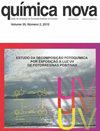evora大学实验室的废物管理(2007-2021)
IF 0.7
4区 化学
Q4 CHEMISTRY, MULTIDISCIPLINARY
引用次数: 0
摘要
Évora大学实验室废物管理(2007-2021)。大学实验室产生的废物是大学废物管理的一个重要组成部分,特别是考虑到它们的危险性和运输成本。为了对这种废物进行良好的管理,了解其产生的数量和组成是必不可少的。然而,这类信息仍然很少。在这项工作中,利用现有记录,调查了2007年至2021年Évora(葡萄牙)大学实验室的废物。在15年的分析中,Évora大学的实验室产生了大约61吨废物,其中88%是有害的,66%是液态的。此外,只有3%的废物进行了回收作业。此外,2019冠状病毒病大流行导致医院产生的废物增加了一倍,实验室活动产生的危险液体废物大幅减少,特别是在大流行的第一年。2021年,即大流行的第二年,“恢复正常”,实验室产生的废物达到最高值8.6吨。最后,讨论了改进实验室废物管理的可能解决方案。本文章由计算机程序翻译,如有差异,请以英文原文为准。
GESTÃO DE RESÍDUOS NOS LABORATÓRIOS DA UNIVERSIDADE DE ÉVORA (2007-2021)
WASTE MANAGEMENT IN THE LABORATORIES OF THE UNIVERSITY OF ÉVORA (2007-2021). Waste generated in university laboratories is an important component of university waste management, especially regarding their hazardousness and, also, the cost involved in their forwarding. To make a good management of this waste, it is essential to know the amount generated and the composition. However, this type of information remains scarce. In this work, waste from the laboratories of the University of Évora (Portugal) was surveyed from 2007 to 2021, using existing records. In the 15 years under analysis, the laboratories of the University of Évora generated about 61 tonnes of waste, 88% of which were hazardous and 66% were in the liquid state. In addition, only 3% of this waste was subjected to recovery operations. Moreover, the COVID-19 pandemic contributed to a double increase in hospital waste generated and to a substantially decreased of hazardous liquid waste from the laboratory activity, especially in the first year of the pandemic. In 2021, the second year of the pandemic, there was a “return to normality”, reaching the highest value of waste generated in the laboratories, of 8.6 tonnes. Finally, possible solutions for improving laboratory waste management were also discussed.
求助全文
通过发布文献求助,成功后即可免费获取论文全文。
去求助
来源期刊

Quimica Nova
化学-化学综合
CiteScore
1.60
自引率
12.50%
发文量
72
审稿时长
2-4 weeks
期刊介绍:
Química Nova publishes in portuguese, spanish and english, original research articles, revisions, technical notes and articles about education in chemistry. All the manuscripts submitted to QN are evaluated by, at least, two reviewers (from Brazil and abroad) of recognized expertise in the field of chemistry involved in the manuscript. The Editorial Council can be eventually asked to review manuscripts. Editors are responsible for the final edition of QN.
 求助内容:
求助内容: 应助结果提醒方式:
应助结果提醒方式:


